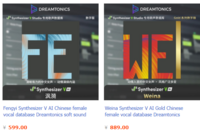One thing we can prove is that a character doesn't guarantee success. During V3 and V4 a huge number of character led voices were heavily marketed in an attempt to recapture Miku's success. The vast majority didn't come close, because people who want a cute character, have Miku. Her success was not just her design, but the unique time in online history when she was released. A new character voice must compete with figures like Miku who're already popular, which is stiff competition. Why would a new producer buy the new character they don't know, instead of an iconic one? The fans who collect new voicebanks are an incredibly small part of the vocal synthesis community: we don't equal success.
Sources from inside Yamaha claim that the Vocaloid division wasn't profitable during V3 and V4, with V5 being the first time in many years that they saw financial success. Although we can't prove hearsay, the fact that Yamaha chose to distance themselves from character marketing provides strong evidence for its failure. Yamaha's disinterest in third parties may be less about poor sales, and more about them learning that third parties aren't necessary.
I think we judge the success of a product based on our limited social media sphere's tastes, and can sometimes forget that we aren't the majority. Knowing this, a company's decisions to pursue other markets doesn't feel as unexpected. Although we all want companies to make the products that appeal to us, we only represent a unique, niche subsection of a much larger industry.
But I don't think fans of character focused products need to fear, mascots are a huge part of vocal synthesis culture, and there's nothing to suggest they're going away. As vocal synthesis becomes more mainstream, we may just see avatar-less voicebanks existing alongside characters more prominently.

























